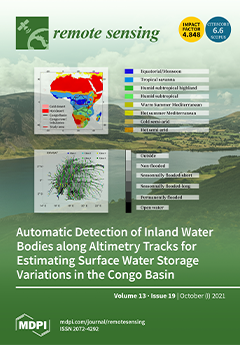Previous studies have observed seasonal cooling effects in paddy rice as compared to temperate forest through enhanced evapotranspiration (
ET) in Northeast Asia, while rare studies have revealed biophysical factors responsible for spatial variations of
ET and its cooling effects. In this
[...] Read more.
Previous studies have observed seasonal cooling effects in paddy rice as compared to temperate forest through enhanced evapotranspiration (
ET) in Northeast Asia, while rare studies have revealed biophysical factors responsible for spatial variations of
ET and its cooling effects. In this study, we adopted a data fusion method that integrated MODIS 8-day surface reflectance products, gridded daily climate data of ground surface, and a remote sensing pixel-based Penman-Monteith ET model (i.e., the RS–PM model) to quantify ET patterns of paddy rice in South Korea from 2011 to 2014. Results indicated that the regional variations of the rice-growing season
ET (
RGS-ET, the sum of daily
ET from the season onset of rapid canopy expansion (
SoS) to the end of the rice-growing season (
EGS)) were primarily influenced by phenological factors (i.e., the length of growing period-
LGP), followed by growing season mean climatic factors (i.e., vapor pressure deficit-
VPD, and air temperature). For regional variations of the paddy field
ET (
PF-ET, the sum of daily
ET from the field flooding and transplanting date detected by satellite observations (
FFTDsat) to
SoS, and to
EGS), the extents were substantially reduced, only accounting for 54% of the
RGS-ET variations. The
FFTDsat and
SoS were considered critical for the reduced
PF-ET variations. In comparison to the temperate forest, changes in monthly ground surface air temperature (
Ts) in paddy fields showed the V-shaped seasonal pattern with significant cooling effects found in late spring and early summer, primarily due to a large decline in daytime
Ts that exceeded the nighttime warming. Bringing
FFTDsat towards late spring and early summer was identified as vital field management practices, causing significant declines in daytime
Ts due to enhanced
ET. Results highlighted climate-warming mitigation by paddy fields due to early flooding practices.
Full article





